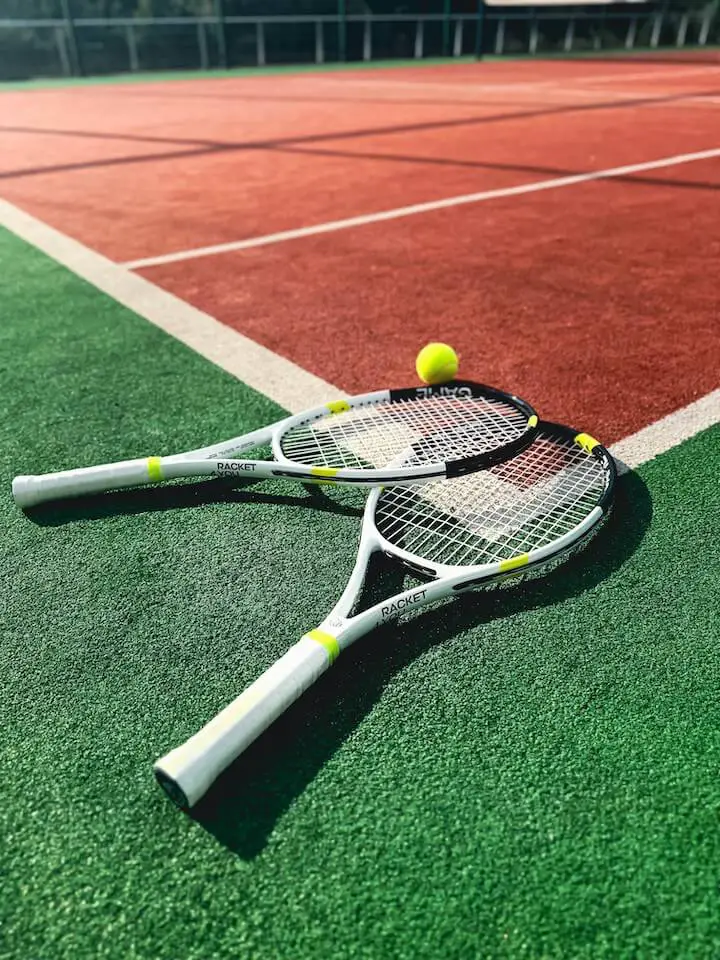
We're an affiliate
We hope you love the products we recommend! Just so you know, we may collect a share of sales or other compensation from the links on this page. Thank you if you use our links, we really appreciate it!
Let me guess—you just started playing tennis, or maybe you’ve been hitting for a while but never really gave much thought to your strings. Maybe you heard someone talk about string tension and thought, “Should I care about that?” Yep, you should. But don’t worry—it’s not as complicated as it sounds. This is why I wrote a string tension guide for beginners.
In fact, if you’ve ever wondered why your shots feel too wild or why they don’t go as deep as you want, your string tension might be the missing piece.
This guide isn’t here to confuse you with technical stuff. I want to help you feel a little more in control of your game, especially when you’re just starting out. So let’s take a slow walk through everything you need to know about string tension—what it does, how it affects your shots, and how to find the right setup for you.
You ready? Let’s go.
Table of Contents
Key Takeaways
- String tension controls how your racket feels and performs.
- Lower tension = more power and comfort; higher tension = more control.
- Beginners should start around 53–55 lbs.
- Don’t jump from low to high too quickly—adjust slowly.
- Track what you try and how it feels.
String Tension Guide For Beginners: What Is String Tension and Why It Matters
Okay, first things first.
When we talk about string tension, we’re talking about how tightly the strings are pulled when they’re installed in your tennis racket. It’s measured in pounds (or kilograms), and it usually ranges somewhere between 45 to 65 lbs.
Think of it like a trampoline. If the trampoline net is pulled super tight, you’re not going to bounce very high. But if it’s a little looser, boom—you bounce up with ease. That’s exactly how tennis strings work.
Higher tension means the strings are tighter. Tighter strings give you more control. Lower tension means they’re looser, and that gives you more power.
It’s one of those things that sounds simple at first, but once you get on court, you start to feel the difference. And believe me—it can be the difference between loving your racket and hating every shot.

Low vs High Tension: What’s the Difference?
Let’s break this down real quick.
Low Tension
This usually means your strings are strung around 45–50 lbs.
Here’s what that feels like:
- You’ll get a softer, more forgiving hit.
- Your ball tends to fly deeper with less effort.
- You’ll feel a bit of a “trampoline effect.” The ball sinks into the strings and springs out.
Who’s this good for?
- Beginners who want to generate power easily.
- Anyone with arm discomfort (less shock on impact).
- People who like to rally from the baseline and want more depth.
High Tension
We’re talking about 55–60+ lbs.
Here’s what this feels like:
- The string bed feels firm, and the ball comes off quicker.
- You’ll need to generate your own power—but you’ll get better control.
- Shots are easier to place exactly where you want them.
Who benefits here?
- Players with fast swings who already hit hard.
- People who prefer control over power.
- Those who like the ball to feel crisp off the strings.
Also Read: How To Buy The Right Tennis Shoes: A Beginner’s Guide
How to Know What’s Right for You
Here’s where most beginners get stuck: “Okay, but what should I use?”
Let’s take a step back.
Ask yourself:
- Are your shots flying long all the time?
You might want to go tighter. - Feel like you’re swinging with all your strength but the ball barely moves?
You probably need lower tension. - Are you just starting out and have no clue how it should feel?
Then it’s smart to start in the middle.
Most rackets suggest a string tension range. You’ll usually see something like 50–60 lbs printed on the inside of the racket’s throat. For beginners, I always recommend trying around 53–55 lbs.
Why? Because it’s safe. It’s balanced. You’re not going to struggle for power, and you won’t completely lose control either. It gives you a good place to build from.
And one more thing—2 or 3 pounds can make a big difference. So don’t make huge jumps. Tweak slowly and see how your game reacts.

Tension Ranges to Try (With Simple Examples)
Let me give you a quick breakdown of common tension ranges and what they feel like:
45–50 lbs:
- You’ll get easy power, especially on your groundstrokes.
- Your shots might float a little if your technique isn’t solid.
- Great if you want to keep rallies going with less effort.
51–54 lbs:
- This is what I call the goldilocks zone for beginners.
- A nice mix of power and control.
- If you’re not sure where to start, start here.
55–60 lbs:
- Feels tight and precise.
- Good for players who already generate power and want accuracy.
- Not ideal if you’re struggling to get depth on your shots.
Most stringers will ask what tension you want, so now you’ll have a better answer than just shrugging.
Should You String Looser or Tighter?
Now this part can be fun—because once you start noticing how different tensions feel, you’ll want to test stuff.
Here’s how you can think about it:
- If the ball is flying long, try going a little tighter.
- Say the ball barely makes it over the net, loosen the tension up a bit.
- If your arm is sore, dropping a few pounds can help soften the feel.
- Say you’re missing your spots, tighter tension can help you aim better.
And here’s something that’s easy to overlook—temperature. On colder days, your strings will feel stiffer. On hot days, they’ll feel looser. So don’t panic if your racket feels different depending on the weather.
Also, different string types (like polyester or synthetic gut) react differently to tension. But don’t overthink that part yet. If you’re still learning, it’s better to just focus on one thing at a time—and tension is a great place to start.
Check Out: 10 Best Tennis Shoes For Beginners
Tips for First-Time Stringing
Alright, so you’re ready to get your racket strung. Maybe for the first time.
Here’s what I’d tell you if we were sitting across the court from each other:
- Start in the middle of your racket’s recommended tension range.
Trust me on this—it gives you the most balanced starting point. - Write it down somewhere.
Every time you get your racket strung, note the tension. That way, you’ll start to see what works for you. - Keep things simple.
Don’t stress about string material, hybrid setups, or pre-stretching yet. Just focus on how different tensions feel when you play. - Restring regularly.
Strings lose tension over time. Even if they don’t break, they stop performing the way they should. For casual players, every 2–3 months is a good rhythm. - Don’t copy someone else’s setup.
What works for your favorite pro or your hitting partner might feel awful for you. This part is personal—and that’s a good thing.

Conclusion
Finding the right string tension might sound technical, but honestly? It’s just about feel.
You don’t need to get it perfect on the first try. Just take it one step at a time. Try something in the middle. Pay attention to how it feels. And don’t be afraid to tweak it next time.
Tennis is full of little experiments like this. That’s part of what makes it fun.
And once you figure out what works for you, your shots will start to feel like yours. Like they belong to your game. And that’s a pretty great feeling.
Frequently Asked Questions
What string tension is best for beginners?
Start with something in the 53–55 lbs range. It gives you a balanced feel—enough power without losing control.
Can string tension affect my arm?
Yes. Lower tension usually feels softer and is easier on the arm. Higher tension can feel harsher, especially with stiff strings.
How often should I change my string tension?
Tension changes naturally as strings lose elasticity. If your shots feel dull or unpredictable, it might be time to restring.
What if I try a tension and hate it?
That’s totally fine. Just adjust it next time—2 to 3 lbs up or down makes a noticeable difference. Don’t be afraid to test and learn.




